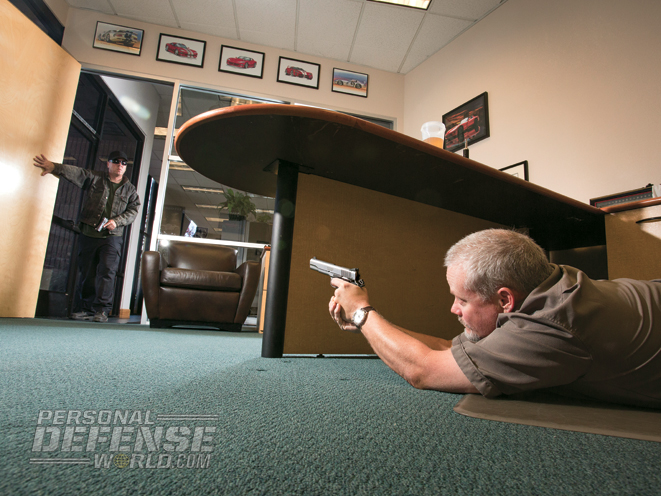When most people think of having to defend themselves, they envision being attacked in a public place away from the security of familiar environments like their home or office. While people who work at convenience stores, banks and similar businesses have probably considered the possibility that they could be involved in a robbery attempt, most people regard their place of work as a safe haven.
Sadly, this isn’t the case. Workplace violence is a very real threat and one that is all too often ignored until it’s too late. According to the Bureau of Justice Statistics’ National Crime Victimization Survey (NCVS), in 2009 alone there were an estimated 572,000 nonfatal violent crimes committed against persons 16 or older while at work. The Bureau of Labor Statistics’ Census of Fatal Occupational Injuries (CFOI) indicates that there were 13,827 workplace homicides in the U.S. between 1992 and 2010—an average of more than 700 homicides per year. CFOI statistics also revealed that homicide is the leading cause of death of women in the workplace.
RELATED: Tips and Tactics for Neutralizing an Active Shooter
Advertisement — Continue Reading Below
Despite these alarming statistics, most businesses do nothing to enhance their security or protect their workers. Those that do choose to acknowledge the issue typically address it in the worst possible way—by banning the carry or possession of weapons on the premises. Obviously, the idea of “breaking a rule” means absolutely nothing to someone intent on physically attacking another person. Such policies do, however, ensure that those who play by the rules are denied the means to defend themselves while at work.
So what can you do to keep yourself safe? Regardless of your employer’s policies, there are concrete steps that you can take to protect yourself from workplace violence and defend yourself against it if it does occur. All it takes is a logical thought process, a little research and a willingness to bend the rules a little.
Assess Your Vulnerability
Advertisement — Continue Reading Below
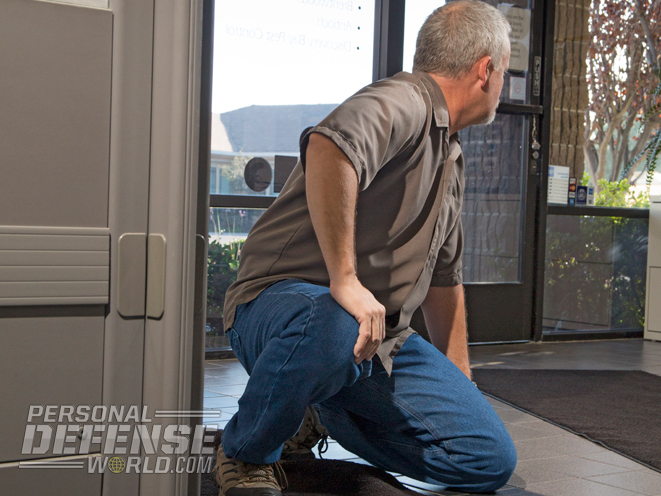
The first step to keeping yourself safe at work should be to assess your risk and your vulnerability to being targeted. While there are no guarantees in life, higher levels of potential risk should motivate you to be even better prepared. Risk is determined by a number of factors that can be identified with a few simple questions:
• Are there any current or former employees that have a grudge against you for any reason?
• Do you hold a position of authority within your company that would increase your chances of being targeted?
• Is the nature of your company’s work controversial or unpopular?
• Do any of your co-workers have issues with anyone that could make them—and potentially you—a target? In particular, are any of them involved in abusive relationships that could prompt a workplace attack?
Advertisement — Continue Reading Below
Just because you answered “no” to all these questions doesn’t mean you’re safe; it just means you don’t have any specific potential threats to worry about, so don’t stop there.
Know Your Environment
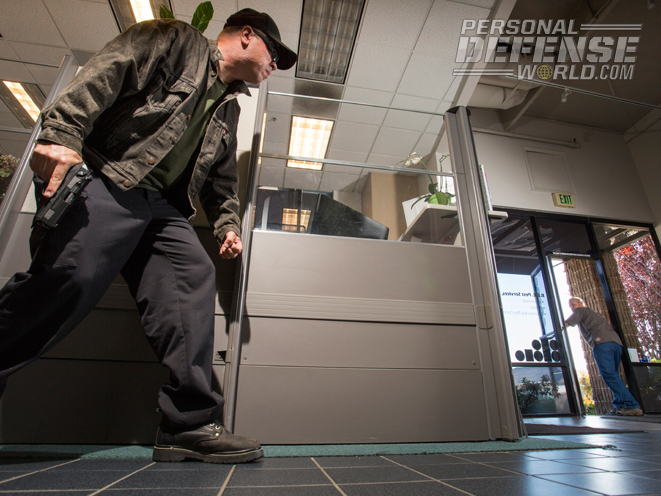
Advertisement — Continue Reading Below
The next step in assessing your vulnerability should be to take a hard look at the physical security of your workplace and the policies that govern your ability to protect yourself and the resources you can use to do it. To guide that process, here’s another simple checklist:
• Are there any barriers that would restrict public access to your workplace?
• Are there any barriers that would restrict public access to your specific office or work station?
• If there are any barriers, would they actually be effective?
• Does your workplace have security guards on duty?
• If your workplace does have security guards, are they armed, well trained and capable, or just a visual deterrent?
• Does your personal work area have a substantial locking door?
• Does the physical structure of your work area (or any of the objects in it) offer any real cover, i.e. will it stop bullets?
• What escape routes are available to you? Do they offer any ballistic protection along the way? And do they actually lead to a safer, more secure location?
• What is your employer’s policy regarding the possession and carry of weapons, especially firearms, in the workplace?
• What is the penalty for violating that policy and are you willing to take that risk?
Run, Hide, Fight?
Advertisement — Continue Reading Below
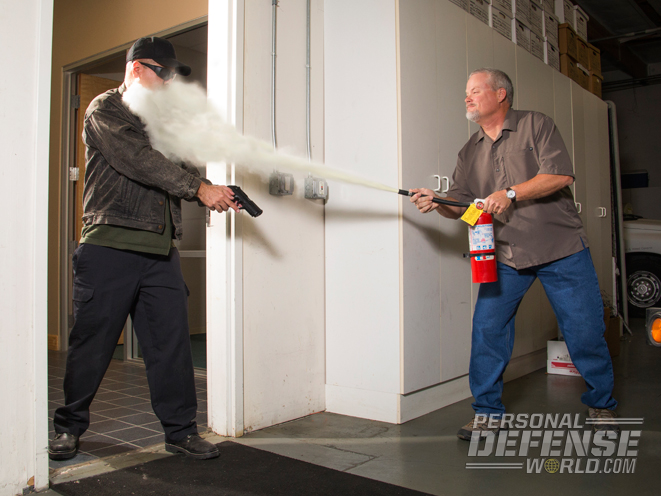
If you research survival strategies for active shooter or workplace violence incidents, you’ll typically get overly simplistic advice like “run, hide, fight.” While that’s not a bad start, in reality, the answers to the questions in the preceding paragraphs are a better basis for formulating your personal reaction plan because they put the problem into context. Face it, if you work in a government building protected by armed security guards and have your own office with a locking door, your personal situation is very different than a sales clerk working the floor in a department store. There is no one-size-fits-all plan that works for both scenarios.
To develop your personal reaction plan, start with the workstation where you spend most of your time. Look at your vulnerability, your ability to see potential threats coming and the other resources it offers to determine your best first-line defense. For example, if you have your own office and it has a locking door, your best bet might be to hunker down in place. This is particularly true if leaving your office to escape would increase your exposure to danger.
Advertisement — Continue Reading Below
RELATED: 3 Tips for Surviving a School Shooting
To increase your chances of survival, look for ways to strengthen your basic defenses. Increase your visibility of potential threats by moving your desk to face likely avenues of approach and to enable you to react quickly to secure the door. Ensure that the door, lock and hardware create as substantial a barrier as possible. Ask permission to install a dead bolt and reinforced strike plate at your expense. At the very least, replace the standard screws in the hinges and strike plate with long deck screws that anchor through the jamb into the surrounding framework.
If other people—especially potential threats—have keys to your office, back up your door lock with a security bar. These inexpensive devices wedge between the doorknob and the floor and are fully adjustable to ensure a proper fit. They are also a perfect choice if your office does not have a locking door but is otherwise a good choice as a safe haven.
Advertisement — Continue Reading Below
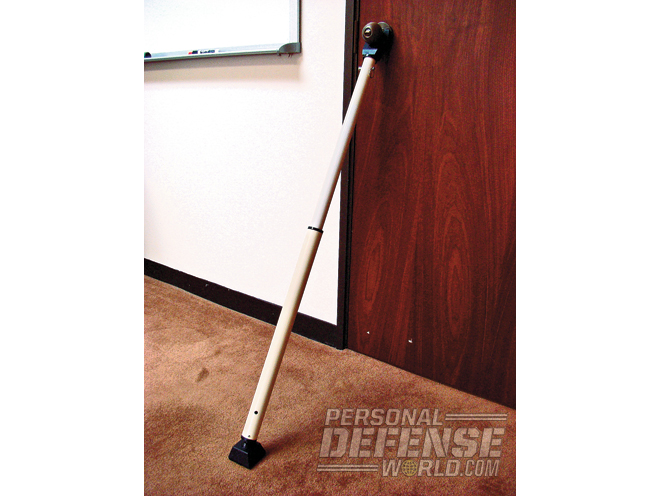
Improve your desk’s ability to function as cover against gunfire by placing phonebooks, hardcover books or reams of paper in the back of each drawer. If possible, position a file cabinet next to your desk and do the same thing with its drawers. Stacked paper makes an amazingly effective bullet stop, so take advantage of it to create walls of substantial cover large enough for you to hide behind.
If the physical barriers you create are not enough to deny an attacker access to your workspace, you should also have some means of fighting back—ideally from a distance. Obviously, the best tool for this job is a firearm, provided your company’s policy—or your willingness to violate that policy—allows it. If you choose this option, plan your firing positions and fields of fire carefully to maximize your use of cover and avoid endangering any of your co-workers.
RELATED: Rescue Essentials’ Active Shooter Event Moulage Kit
Advertisement — Continue Reading Below
If a firearm is not an option, stream-style pepper spray is an alternative that can give you a fighting chance. Although pitting a less-lethal weapon against a lethal threat is never ideal, a stream spray allows you to engage the attacker from a distance, minimizes your exposure to the effects of the spray (unlike fogs which create aerosol mists), and seriously affects the attacker’s ability to target you effectively.
One very “PC” alternative to pepper spray is a chemical fire extinguisher. Although not a purpose-designed weapon, it can definitely blind and debilitate an attacker from a distance. It also delivers a greater volume of spray and doubles as a potent impact weapon at contact distance. Best of all, it easily flies under the radar in even the strictest non-permissive environments.
Safe Escape
Escape should also be part of your defensive strategy against workplace violence, especially if your workstation is not suitable for a “hunker down” defense. However, you must still have a sound plan of action. Simply running “away” isn’t good enough. Choose routes that allow you to “leapfrog” from cover to cover to protect you against gunfire. Whenever possible, include options to “branch” from your route to alternate routes if necessary. Review your routes frequently during your normal work activities and practice initiating them from different starting points. Most importantly, establish a firm, safe defensible destination to run to. Just getting out of the building isn’t good enough.
Workplace violence is a real issue that can only be addressed effectively on an individual level. Do your homework, assess your risks and take decisive steps to build strong defenses in your workplace. You’re on your own, so get to work!
